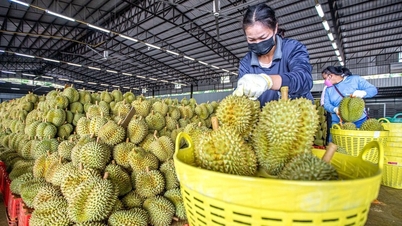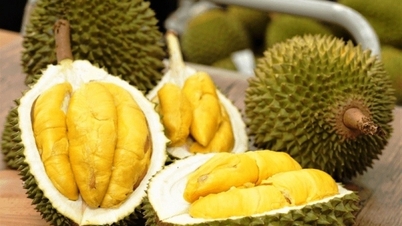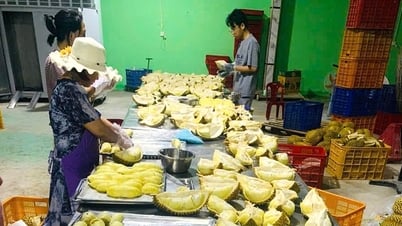Since Vietnam officially exported durian to China, 30 shipments have been returned due to cadmium exceeding the threshold. A representative of the Plant Protection Department said they are investigating the cause.
On the afternoon of April 1, at the regular press conference of the first quarter, Mr. Nguyen Quang Hieu, head of the International Cooperation Department (Plant Protection Department, Ministry of Agriculture and Rural Development) said that the 30 returned durian shipments were calculated from the time Vietnam officially exported this product to China from September 2022, accounting for only 0.01%.
According to Mr. Hieu, the 30 shipments with cadmium heavy metal content exceeding the limit have not yet affected durian exports, but this is a warning for producers.

Mr. Hieu informed about 30 batches of cadmium-contaminated durian returned by China. Photo: Viet An
To date, the Plant Protection Department has not yet found the specific cause of cadmium exceeding the threshold, because this substance comes from many different sources: in soil, water, and nature. However, Mr. Hieu said that it could be due to the soil being contaminated with cadmium or the water and emissions from the factory. It could also be due to the water used to wash the products after harvest being contaminated with cadmium.
From the above causes, the Plant Protection Department recommends that production units need to adjust input materials and farming methods to reduce cadmium absorption. Before exporting, they should also carefully check the cadmium content.
Previously, in May and June 2023, China discovered and warned that 6 shipments of Vietnamese durian exported contained cadmium exceeding the prescribed threshold.
Four months later, China discovered another batch of violations. From November 2023 to January 2024, China continuously discovered and warned of 23 more durian batches contaminated with cadmium. Two businesses in Lang Son and Hanoi are said to have the most contaminated batches, with 8 batches.
According to the Vietnam Fruit and Vegetable Association, China has previously warned about this issue but at a mild level, but this time it is more serious. Therefore, Vietnam needs to quickly find the cause and fix it to ensure the reputation of the durian industry in general and Vietnamese fruits and vegetables in particular.
After receiving the warning from China Customs, the Plant Protection Department sent a dispatch to relevant localities to review the cause. At the same time, the Department also proposed to apply preventive measures to avoid recurrence of violations.
In July 2022, the Ministry of Agriculture and Rural Development signed a protocol with the General Administration of Customs of China on plant quarantine requirements for durian exported from Vietnam. Durian must comply with China's laws, regulations and standards related to food hygiene and safety, as well as plant quarantine requirements. Durian growing areas and packaging facilities must eliminate pests such as fruit flies and mealybugs; there must be no pesticide residues exceeding the permitted level...
According to data from China Customs, in 2023, China imported durian from Vietnam, up 1,107% in volume and 1,035.8% in value compared to 2022. In 2023, China imported 493 thousand tons of durian from Vietnam, worth 2.1 billion USD.
Vietnam currently has 876 durian growing area codes and packing facility codes that are eligible for export to this country of one billion people. Of these, 708 growing area codes are licensed.
Viet An - Thi Ha
Source link



![[Photo] National Assembly Chairman Tran Thanh Man chairs the meeting of the Subcommittee on Documents of the First National Assembly Party Congress](https://vphoto.vietnam.vn/thumb/1200x675/vietnam/resource/IMAGE/2025/5/8/72b19a73d94a4affab411fd8c87f4f8d)
![[Photo] General Secretary concludes visit to Azerbaijan, departs for visit to Russian Federation](https://vphoto.vietnam.vn/thumb/1200x675/vietnam/resource/IMAGE/2025/5/8/7a135ad280314b66917ad278ce0e26fa)
![[Photo] President Luong Cuong presents the decision to appoint Deputy Head of the Office of the President](https://vphoto.vietnam.vn/thumb/1200x675/vietnam/resource/IMAGE/2025/5/8/501f8ee192f3476ab9f7579c57b423ad)
![[Photo] Prime Minister Pham Minh Chinh meets with the Policy Advisory Council on Private Economic Development](https://vphoto.vietnam.vn/thumb/1200x675/vietnam/resource/IMAGE/2025/5/8/387da60b85cc489ab2aed8442fc3b14a)
![[Photo] General Secretary To Lam begins official visit to Russia and attends the 80th Anniversary of Victory over Fascism](https://vphoto.vietnam.vn/thumb/1200x675/vietnam/resource/IMAGE/2025/5/8/5d2566d7f67d4a1e9b88bc677831ec9d)


























































![[Photo] Prime Minister Pham Minh Chinh talks on the phone with Singaporean Prime Minister Lawrence Wong](https://vphoto.vietnam.vn/thumb/402x226/vietnam/resource/IMAGE/2025/5/8/e2eab082d9bc4fc4a360b28fa0ab94de)































Comment (0)